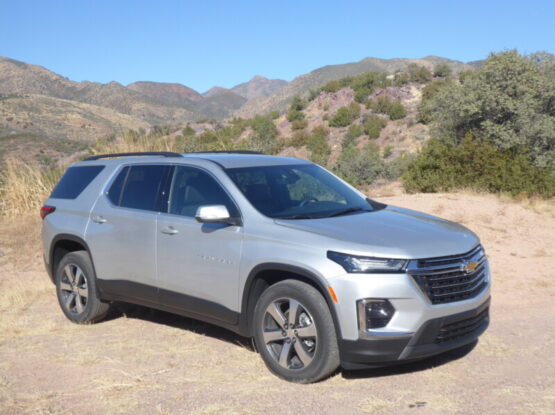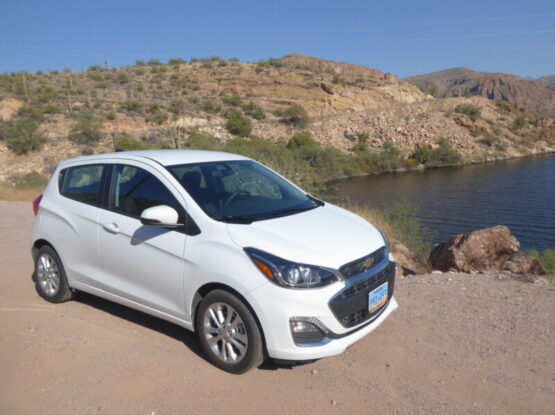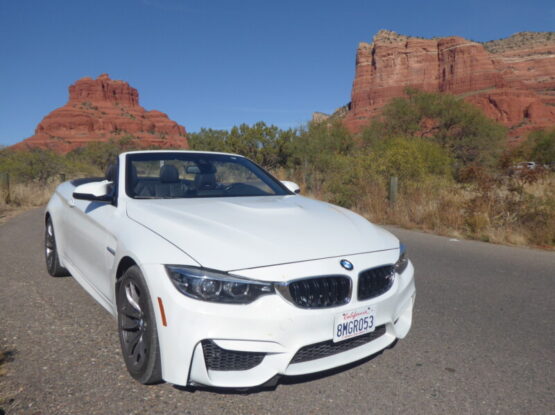































I’ve been trying to get hold of a Fusion ever since the cars hit US streets. Hertz had a small number of them right from launch, but they always seemed so popular that whenever I saw one parked up, it had already been allocated to someone else. That was clearly a good sign that it was worth persisting. Finally, my luck was in and when wandering a facility packed with cars, I found quite a few of them parked up, though I have to observe that from the rear the Fusion bears an uncanny resemblance to the latest Hyundai Sonata and a good few of those fooled me into thinking that there were some Fusions in more interesting colours than Grey. The best I could do was one in Ingot Silver, but it was almost new with only 4400 miles on the clock. I took it, eagerly anticipating what should prove to be one of the stars of its highly competitive class.
The engine line-up for the Fusion is very different from the Mondeo. No diesels here, but a choice of three petrols, a Hybrid and a plug-in hybrid electric model, the Energi. There was one of the Hybrid versions at Hertz when I collected this one, but it was allocated, so sampling that will be for another day. With no Ecoboost badged cars in sight – and Ford offer you the 1.5 litre turbo which puts out 181 bhp or the more potent 2 litre 231 bhp unit – my test car was the entry level 2.5 litre 4 cylinder version. It puts out 175 bhp which is absolutely in the middle of the list of power outputs among its rivals. The test car came coupled with a six speed automatic gearbox. It is not a happy combination. I think the bigger problem is the gearbox which seemed dim-witted, unable to decide that it needed to change down a gear or two, with the result that the car struggled to pick-up or even maintain speed when climbing even a gentle incline or if baulked in traffic. On the canyon roads in the hills above Malibu it was particularly frustrating. I tried putting it in Sport mode as opposed to Drive, and this made precious little difference. When you do get some life out of the engine, you realise that it is not aurally a particularly endearing experience. It is not particularly loud, unless you really rev the engine hard, and it is still decently smooth, but this engine is going to win no prizes. It is a carry-over from the old model Fusion, where I don’t remember it being as off the pace as this. No wonder Ford put far more emphasis on the Ecoboost models. It does at least deliver decent economy, though. I covered 335 miles in the test car in a mixture of driving from the morning queues from the LAX airport up to Santa Monica and Malibu, the challenging canyon roads which combine moderate gradients with plenty of tight bends heading over the Malibu hills and into the valley, and then a long freeway haul east out towards the Palm Springs area, and at the end of it all, the trip computer, and backed up by my calculations, said 30.8 mpg US, which is 36.8 mpg Imperial, a very creditable figure for a large family saloon. My expectations were that this would be a good car to take on those twisty roads, as it should come with Ford’s legendary excellence in steering feel and handling. Indeed, all the (US) reviews of the Fusion praise its sporty handling. I have to say that I was disappointed. Not because the Fusion is bad in this regard, like a Toyota Camry is. As it certainly is not. It is just that I was expecting better. There’s some feel to the steering, which is of course far better than a lot of cars manage, such as the Toyota Avensis that I had driven in the UK the day before, but if you think this is anywhere close to the standards of say the second generation Mondeo, prepare yourself now for the fact that it is not. There is a decent linear progression of feel as you turn the wheel more, and the car does corner well, with minimal body roll and understeer well tamed, perhaps because the gearbox will ensure you are not in the right gear and going fast enough to get into trouble! But an attribute that bests the class? No, not there. The Fusion does ride well, though, and on California’s poorly maintained roads, where you encounter everything from concrete ridges to gigantic crater-sized pot holes as well as some decently surfaced tarmac, that is all to the good. With low noise levels when cruising at a steady speed, it makes the Fusion a relaxed long distance companion. The brakes needed a fairly firm push with a dead bit of travel initially before anything happened, but then they proved well up to their task. There is an electronic handbrake, operated by a small button in the centre console to the rear of the gear lever. Visibility is a mixed bag. The door mirrors have a second piece in the upper outer corners which do an excellent job at covering any blind spot. It is behind you where things get tricky, as the steeply angled rear screen means that you have no idea where the back of the Ford is. Luckily, and perhaps a tacit admission of this, there is a back-up camera fitted, projecting an image onto the Infotainment screen, so there is no real problem in manoeuvering the car in tight spots.
Inside, it is clear that the US team have done a better job than the European ones who give us the mess that is the current Focus. There’s a nice cohesive design, and a good choice of materials so the initial impression is that this is among the better interiors of its rivals, where standards are constantly improving. The seat trim and main mouldings were black, but there is judicious use of dark grey inlays and a piano black inset around the gearlever which look far better than the fake wood or cheap silver plastic that have afflicted many recent Blue Oval products. Look a bit closer, though, and the good feelings diminish a bit, as there are still an awful lot of small and fiddly buttons in the centre of the dash. The basics are right, though. There are two large dials under a single cowl, with clear markings and turquoise coloured pointers, with rev counter on the left and speedo on the right, and smaller gauges for water temperature and fuel level inset into the lower segment of these, respectively. Between the dials is the digital display area which you can customise by dint of the array of buttons on the left spoke of the steering wheel. These cover everything from trip distance and average fuel economy to changing various vehicle settings or showing what is playing on the audio system. Twin column stalks operate indicators and wipers, and the lights function from a rotary dial on the dash to the left of the wheel. It is the middle of the dash where the design has its problems. There is a small integrated display screen for the Infotainment system. On this version it is not touch sensitive, so that means lots of buttons. To its left are the ones for the screen and its set up and to the right is the equivalent of a phone key pad. Underneath it are a vast array of buttons and knobs for the audio unit and under this are another array of buttons for the air conditioning set up. I never did discover if you can display any of this last on the screen, but as this is air conditioning and not automated climate control, I doubt it. It proved reasonably intuitive, and once you are familiar with it, would doubtless not be an issue, but for the first few minutes, it looked far too complicated and most of the buttons are very small making them hard to stab at in a hurry. The button fest continues on the steering wheel boss, as there are an array of them set in the sides of the lower spokes for cruise control. Those on the right spoke are for audio control repeater functions. The wheel itself is a plastic moulding, but it was one of the better ones, not unpleasant to hold.
Slightly surprisingly for the volume selling and near to base model in this class, seat adjustment for the driver and front passenger was electric, with switches on the side of the seat, where you will also find a lumbar support. The steering wheel telescopes in/out as well as up/down, so getting the perfect driving position was not hard. What was difficult, though, was getting comfortable. It felt to me as if the shape of the seats themselves was not quite right, with too little padding in both the cushion and the backrest. It is rare these days to find a car seat in which you cannot feel comfortable but this was one. Clearly all my test mileage was done from the driver’s seat, so I can only comment on the rear seats based on sitting in them as a quick test. There’s certainly no shortage of space, with ample leg room even if the front seat is set well back. With it set for my driving position, there is masses of space. Width across the car is not an issue, either and despite the sloping roofline, my head was some way off touch the headlining. There is a drop down central armrest which has twin cupholders in is upper face. Rear seat passengers also get a pair of rear vents and there are map pockets on the back of the front seats. Indeed, there are plenty of places to put things inside the cabin, with a generous split level glovebox, a large area in front of the gear lever, almost Volvo-esque in its difficulty of access, a cubby under the central armrest and modest door bins. The boot is a good size, being particularly long from front to back, though the opening is fairly narrow, so this might dictate what you could get in there. There is a bit of space around the space saver under the boot floor for odds and ends. The rear seat backrests are split and fold forwards, released from inside the car.
US buyers get a choice of three trim levels; S, SE and Titanium. The last of these has the 2 litre Ecoboost engine as standard, whilst this is an option on the SE, as is the less powerful 1.5 version. The S trim only comes with the 2.5 litre 4 cylinder engine. S and SE models have a six speed automatic gearbox as standard, whilst the Titanium has a CVT ‘box. SE and Titanium models are also available optionally with All Wheel Drive. 2016 pricing for an S starts at $22,600, and it is not quite as basic as you might fear, with the standard spec including 16″ alloys, body coloured door handles, lower sills in black, solar tinted glass, an alarm and anti-theft system, a backup camera, cruise control, auto headlights, air conditioning, remote boot release, one touch power operated front windows, and Ford’s MySync system with a colour display screen, voice activation including an audio unit with AM/FM radio, single slot CD, MP3 and AUX slot and wheel mounted repeater controls, along with the Ford Message Centre. It costs another $1570 to jump to the SE, which brings with it 17″ alloy wheels, the SecuriCode keyless entry system, a rear centre armrest, 6 speakers and XM Satellite radio, heated mirrors with puddle lights and integrated turn signals, and power adjustable front seats, 10 way for the driver and 6 way for the passenger, a compass, an exterior temperature sensor, rear seat power outlets and air vents. The Titanium is a lot more costly at $31,120 for a front wheel drive car, but as well as the more powerful 2 litre Turbo engine you are also getting lower profile tyres on 17″ rims, dual bright exhaust tips, a leather wrapped steering wheel, rear parking sensors, keyless starting, a mirror memory, an upgraded premium sound system, dual zone automated climate control, leather seat trim with heated driver’s seat and a seat memory, All three trims are available with the Hybrid engine and SE and Titanium models are available in the plug-in electric hybrid Energi version.
My expectations were very high for the Fusion, and it is fair to say that I was a little disappointed. It’s not a bad car. Indeed, far from it, it is, in most respects, a very able machine. But having sampled most of its US market competitors, which with the notable example of the best-selling Camry, are all very good, given that the Ford is often placed at or near the top of the comparisons, then I was expecting it to be really very special. And it was not. I think the combination of engine and gearbox were the elements that frustrated the most. Give it the Ecoboost engine, even the one with only another 6 bhp, and things may well be better. Perhaps I should have expected that the venerable 2.5 litre engine, which was not the strongest aspect of the old model, it has to be said, would prove to be the weakest link. That the steering and handling were not as class-supreme as everyone would have you believe was more of a surprise, and a disappointment. Not that they were not still good, and for anyone who has to put with the feel-less and soggy Camry, nothing short of a revelation, but I still remember the second generation Mondeo and this was not even close to as feelsome as that model was. In all other respects, the Fusion impressed, offering plenty of space and comfort, a decent level of equipment and even a Ford MySync system that did not have me cursing as much as sometimes has been the case. Before I’d driven this car, I was pretty sure that the Fusion was a Top Three of US market family sized saloons. And it probably is, easily beating the Camry, not quite so readily seeing off the Nissan Altima, recently superceded Chevy Malibu, the rather bland Subaru Legacy, the commodious US market Passat and the Chrysler 200. I’ve not yet tried the latest Hyundai Sonata and Kia Optima and would expect them to put up quite a fight for class supremacy, so they join the Ford in the fight for the title. I suspect that the Korean duo don’t quite make it, and frankly nor does the Fusion, which I don’t think is quite the best in class. Although I’ve not driven one on American soil, and Hertz US don’t, for some inexplicable reason, seem to stock them, I was so impressed by the Mazda 6 that I reckon it is the family car that the driver can enjoy at least as much as the passengers. It would be my choice. But if there’s not one available, then the Ford is in with a shout. I am going to see if I can find an Ecoboost one to see if that changes my opinion in the Blue Oval’s favour.





































